- Rugby Toolbox
- Resources & Education
- Learn more
- Articles
- Snook on Coaching
- Under 11/13 – Ruck Defence
- Ruck & Run Drill
- Playing Philosophy – Ruck & Run Coaching Components
- Playing Philosophy – Spread the Forwards
- Playing Philosophy – A forward behind the ruck
- Playing Philosophy – Ruck & Run
- Playing Philosophy – An idea!
- The Breakdown
- Building Positivity [3]
- Building Positivity [2]
- Building Positivity
- Fitness and Game Related Activities
- Getting the Head Working
- Missiles are Dangerous
- Use of Video
- Winger Attacking Outside First-Five
- Player Profiling
- Selection
- Fitness Away from the Team Session
- Playing Philosophy (Pre season Prep)
- Coaching the Coaches
- The Rugby Coordinator and Pre-Season Preparation
- Why Not Use Tap Penalties More Often?
- Why Kick the Ball Down the Middle of the Field?
- Defending the 5 Metre Lineout Drive
- Scoring from the 5 Metre Lineout
- What are the Kicking Team Aiming to Achieve from Halfway Restart
- Should We Practice Scoring Tries?
- Team Culture
- Looking After Your Players
- Coach Survival Tips
- Under 11/13 – Backline Defence
- Under 11/13 – Ruck Defence
- Under 11/13 – Back Attack
- Under 13 – The Counter Attack
- Under 11/13 – The Maul
- Under 11/13 – Lineouts
- Under 11/13 – Decision Making
- Under 11/13 – Support Play
- Under 11/13 – Dive Pass and More
- Under 11/13 – Drop & Grubber Kick /Highball Catch
- Under 11/13 – Front on Tackling
- Under 11/13 – Contact – Getting Up – The Ruck
- Under 11/13 – The Coaching Session
- Under 8/10 – Using Space
- Under 8/10 – Kicking
- Under 8/10 – Contact and Picking Up the Ball
- U8/U10 Draw & Pass and Sidestep
- Under 8/10 – The Tackle
- Under 8/10 – The Coaching Session
- Under 7 – Test Your Coaching – Support Play
- Tap Pass and Swerve U7
- Ball Familiarisation; Passing & Receiving
- Activities for the Non-Contact Tackle
- Under 7 – The Coaching Session
- Coaching Teenagers – After the Ruck
- Coaching Teenagers – The Practice Session
- Coaching Teenagers – Best Practice
- Coaching Kids – Best Practice
- Plays from a Tap Penalty
- Running Plays from a 5 Man Lineout
- Driving Plays from a 5 Man Lineout
- Strike Plays at the End of the Lineout
- Back Strike Plays at the Lineout
- Wide Strike at the Scrum (2)
- Wide Strike at the Scrum
- Midfield Attack at the Scrum
- No 8 Plays at the Scrum (2)
- No 8 Plays at the Scrum
- The Cut Out Pass
- Skills to Penetrate (2)
- Skills to Penetrate
- Movements to Penetrate
- Patterns to Penetrate
- Contact and Continuity
- Keeping the Ball Alive Out Wide
- Pre Season Support Activities
- Checklist
- Understanding the game
- The Playing Philosophy
- The Lineout
- Overview
- Team Profile
- Start Now!
- Backrow
- Nine and Ten
- Rugby-related Fitness Activities
- The Psychological Edge
- Open Field Play
- Key Performance Indicators
- Improving Team Performance
- Backline Attack Concepts
- Tactics at Phase Play
- Playing Philosophy
- The ‘Stop Focus’
- Kick Attack
- Clearing the 22
- Wide Attack at Phase
- Player Focus
- Scrum Preparation
- Lineout Preparation
- Back Attack Preparation
- Sevens Preparation
- Sevens Kick Offs
- Sevens Scrum and Lineout
- Sevens Attack Patterns
- Sevens Defence
- 7's Selection and Game Planning
- Coaching and Leadership
- How the Game Evolves
- Changing Within the Game
- Learning from the Television.
- Using Tap Penalties Wisely
- Defence Drills
- Defence Drills for Tight Five
- Team Defence and TUB’ing
- Establishing Patterns from the Ruck
- Structured Phase Play
- Structuring Phase Play on the Run
- Coaching Roles
- Structuring a Close in Tackling/Defensive Session
- Coaching in Threes
- Attacking Back Play
- Kick Off Chase
- Wrap Around Back Plays
- Lineout Plans
- Looking and Learning
- Motivating Your Players
- Scrum Attack
- Refocusing the Team
- Monitoring the Progress
- Learning the Game
- Playing to the Laws
- Small is OK
- Decisions After the Tackle
- Improving Your Coaching
- Food for Thought
- More Food for Thought
- Passing & Catching
- How Ireland Nearly Beat the All Blacks
- The Progressive Coach
- Try Something New
- Encouraging Excitement
- The Mental Approach
- Where to Start
- Being the Best You Can Be
- Off the Ball Decisions
- Lineouts Difficult to Master
- Decisions on the Run
- Rucking and Rolling
- A Successful Approach
- Gaining Clarity
- Manipulation vs Physicality
- Beating the Drift
- To Ruck or Not to Ruck
- Stopping the Lineout Drive
- Fine Tuning the Planning
- It's a Running Game
- RugbySmart 2015
- Using the Shoulders
- Loosehead Prop / Tighthead Prop
- Position Specific – Hooker
- Position Specific – Lock
- Position Specific – Blindside Flanker
- Position Specific – Openside Flanker
- Position Specific – No 8
- Position Specific – Halfback
- Position Specific – First Five Eighth
- Position Specific – Second Five Eighth
- Position Specific – Centre Three-quarter
- Position Specific – Wing
- Position Specific – Fullback
Under 11/13 – Ruck Defence
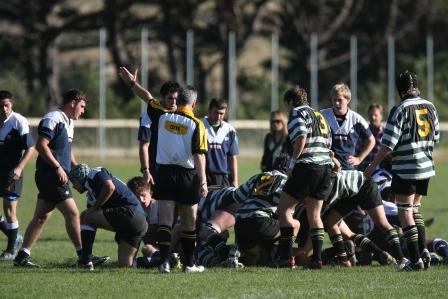
Objective
To prevent the opposition team from scoring.
To create pressure and regain possession.
Key Factors
- Contest possession. Compete hard in scrum, lineout and kick off on their ball.
- Go forward. When the opposition have won the ball reduce their time and space by going forward in to the tackle area.
- Support each other and work together. Each player must understand their role within the defensive pattern.
- Apply pressure by going forward together and making effective tackles.
- Regain possession by making effective tackles with the support of a second defender who will regather the ball or clean out the opposition player attempting to recycle the ball.
- Counter attack when the ball is regained.
Important Concepts
At the TACKLE/RUCK
• 2 in all tackles. a) down low & take player to ground. 2nd man in on the ball.
b) first tackler in a strong driving position. 2nd tackler in and assisting with the drive. (Double tackling) (First tackler: HITMAN. Second tackler: DESTROYER)
• 3rd player is looking at the tackle area and has to decide: enter the zone and create go forward and pressure on halfback getting the ball OR is it a lost cause (LC) in which they will take up the ‘A’ defensive spot on the far side of the ruck/tackle.
• 4th player will be TUBing and go through the same decision making process. If they go in to the ruck you must win the ball by the players driving in over the ball or securing it by hand. If it is a LC they will either take up the ‘A’ on the far side or on the close side if that position is filled.
• The 5th & 6th arrivals must be TUBing (TUB= Them-Us-Ball. This is about looking and thinking) so that they make good decisions. They in particular need to scan the opposition to see where they are heading and then scan their own team to see where they need to be to fill the appropriate channels. In many scenarios they will be the ‘B’ & ‘C’ defenders on the open side.
• The 7th forward will need to TUB and pick their spot in the defensive line. It may be filling holes that the backs have left in midfield or out wide or it may be on the blindside. They need to work quickly.
• The 8th forward will have a role in midfield to take the defensive line up at pace.
Diagram
These defenders all move forward and push across in the line together. The tacklers get up and move forward in the line. Players only break the line once the ball is two passes away at least and they are going backwards. 9 is in the pocket a couple of metres back – they will cover the chip kick and fill any holes in the defensive line.
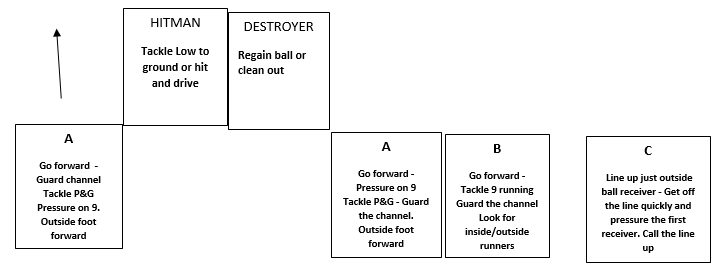
SUMMARY: Sprint to the tackle point - carry out the 3 point check on the way (TUB) Them – Us – Ball - make decisions (I look - I think – I see – I act)
Form a line as soon as possible. Communicate your position. – Go forward with pace – place them under pressure – stay in the line – work hard – keep TUBing
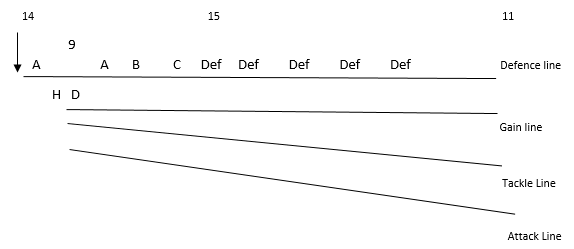
ACTIVITIES for RUCK DEFENCE
Warm Up Drills
1- D=Defender. 2 hit shields carried by attackers.
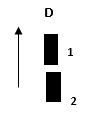 Defender in a crouched position with one foot forward a metre away from hit shield 1.
Defender in a crouched position with one foot forward a metre away from hit shield 1.
Hit shield 2 comes from behind HS 1 on either side and is tackled by D
D gets shoulder on and drives 2 backwards with fierce leg drive.
10 hits each using both shoulders.
2- Same set up with 1 & 2 walking forward slowly and D walking backwards with little steps.
When 2 advances the defender goes forward and makes the hit and drive then quickly gets back in to position.

2’s either send one through the middle or one or other to either side.
Both D’s work together with second tackler going to the far side.
Simulation at the Ruck

A1 either runs or passes. The attack can change direction using scissors, increase numbers using wraps and so on.
The defenders (A,B,C & D) go forward in a line and mark their channel.
When the ball has been passed they stay in the line and push across from the inside allowing the defenders on their outside to move out a channel if necessary. Do not run behind the defensive line once the ball has been passed out of the channel they are defending initially.
It is crucial the ‘A’ defender is not beaten by a dummy or an inside pass from A1.
When they are ready the defence can use tackle suits and get their shoulders in to the tackle.
2- 4 v 5 continuous (5 v 6 / 6 v 7)
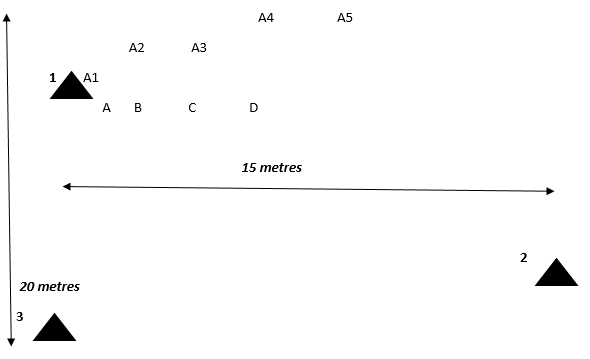
Start at ruck 1 / coach will whistle it up after 1 or 2 phases. On the whistle the players all head to ruck 2 where there is another ball. On the coaches call A1 (or the player in that position) will action the play.
Things to watch for with the defence include: running quickly to get in to position; forming a line on the way back and making sure they are not all heading for the ruck; looking back to see where the opposition are lining up and looking to see where the team mates are so that the spacing is correct; turning and facing up ready to go forward together.
Initially the coach should wait until the defence are organised and coach them through it.
Then after a couple more phases move on to ruck 3.
Progress to:
Going quicker at each ruck
Tackling
Introducing more players and getting the first defender to the far side of the ruck.
(Remember in a real game the defenders need to check on the attackers to see which side they need to run to defend)